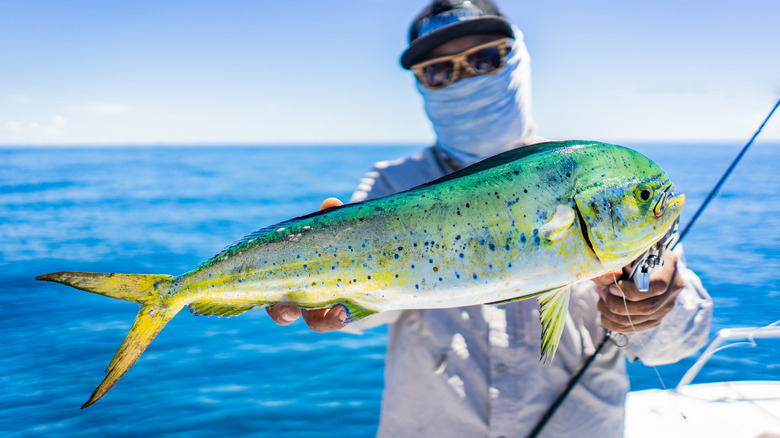What Those Red Lines On Mahi Mahi Really Mean
Mahi-mahi is a surface-dwelling, ray-finned fish that flourishes in the waters around the Gulf of Mexico, the Caribbean, and Hawaii. Although it's also known as dolphinfish (an alternative name it got because of its habit of swimming in front of sailing ships, similar to dolphins), it is not at all related to mammal dolphins (per AZ Animals). The males of this fish species have a prominent protruding forehead, while females have more of a round, tapered head.
While mahi-mahi is a highly sought-after game fish due to its size, difficulty of catch, and iridescent colors, its versatility has made it a deservedly popular menu item in seafood restaurants. It has a distinctly mild and sweet taste, with a stronger "fishy" flavor than cod or halibut. The denseness of mahi-mahi is similar to that of swordfish, but it lacks a steak-like texture and flakes easily if properly cooked. This low-calorie fish offers plenty of health benefits and is a rich source of lean protein, vitamins B3 and B6, and minerals such as selenium and potassium, per Livestrong.
Preparing this lean fish is easy and delivers fantastic results, regardless of the cooking method you choose. It doesn't fall apart easily and retains the large flakes when cooked, making it an ideal choice for grilling. But many people notice the red lines on mahi-mahi and wonder if the fish is safe to consume. But those red stripes aren't a cause for concern.
The red stripes are actually blood lines
Preparing mahi-mahi can get a little messy, but it's worth it. The fish meat should be pink to beige in color with red spots or stripes and occasional light bluish tinges. The dark red stripes are actually blood lines and are perfectly safe to eat. However, removing them with a thin knife would be the best approach for achieving a mild taste that's not too "fishy" (per Food Network).
If you notice dark brown areas and a "slimy" coat, especially along the edges, it means the mahi-mahi is past its prime. Other signs of fish-gone-bad are a pungent smell and milky color. Therefore, it's best not to risk your health and throw away the fish if you notice any warning signs. Moreover, it's essential to remember that you shouldn't let fish sit on the counter for more than two hours, per the USDA. (And if you're planning to cook the mahi-mahi later, avoid this mistake when freezing fish.)
Now that you know what the red lines on mahi-mahi really mean, what's stopping you from trying this delicious baked mahi-mahi recipe or the ever-popular grilling method?

